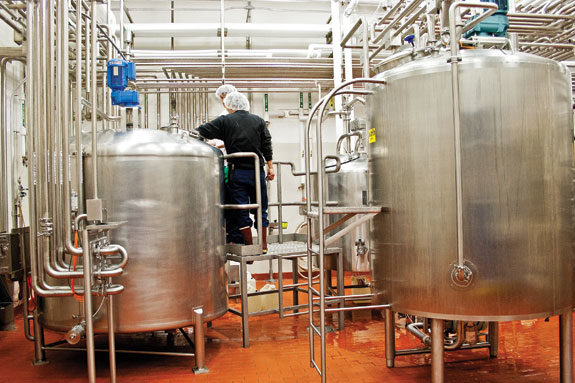Although South Dakota State University (SDSU) may be known for its diverse academic offerings and even its Hobo Day celebration, another source of recognition for the university is stemming from the dairy science program’s new dairy processing facility, Davis Dairy Plant. Construction of Davis Dairy Plant, located on SDSU’s campus in Brookings, South Dakota, concluded in the spring of 2011 and is currently producing a variety of dairy products.
A dedication ceremony also took place in October of last year for the dairy plant and SDSU’s Alfred Dairy Science Hall.
Although the first batch of ice cream at the new dairy plant was produced a little more than a year ago, planning for the new manufacturing plant began more than a decade ago.
Faculty members, including current dairy science department head Vikram Mistry and dairy science instructor Howard Bonnemann, were instrumental throughout the planning and preconstruction process, says dairy plant manager Jake Anderson.
SDSU Davis Dairy Plant
The dairy department did have an older dairy plant facility in operation prior to the new facility being built. The older facility, built in 1961, was remodeled during the construction of the new manufacturing facility and repurposed as a research and development plant.
The new plant boasts 10,850 square feet of space and new state-of-the-art features, with the complete facility extending 17,900 square feet.
The plant, including the cost of all the equipment, totaled $9.3 million. Funding for the plant came from several entities, including processors Davisco Foods and Glanbia, as well as dairy producers and SDSU alumni.
With the newly added manufacturing facility, the plant is able to process three main products on a regular basis – fluid milk, ice cream and cheese. Anderson explains that the plant additionally processes a batch of butter every three months.
“The fluid milk goes out to the university’s dining services here on campus, and the cheese is sold mainly on campus,” Anderson says. “Ice cream is kind of what we are known for, so we have several locations throughout eastern South Dakota that sell our ice cream.”
Anderson says that after they were up and going and had made the first ice cream batch, the other dairy product processes fell into place.
He explains that the dairy facility vision became a reality in large part due to Davisco Foods International , which took care of the equipment installation and computer programming.
The new plant was also named in honor of the Davis family, owners of Davisco Foods.
Plant workflow
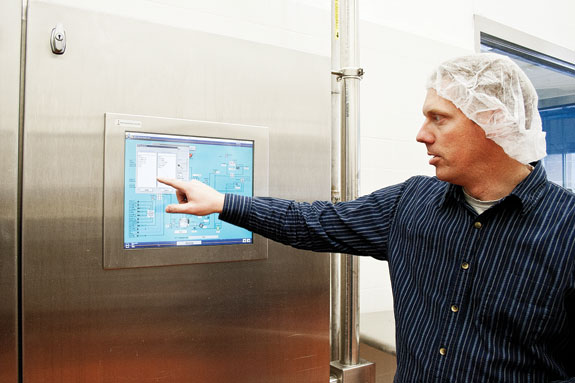
Anderson, a 2004 SDSU dairy science program graduate, worked for a Davisco Foods plant in Lake Norden, South Dakota, for 6.5 years before being hired as the Davis Dairy Plant manager in January of 2011.
Although he wasn’t involved in the initial plans for the dairy plant or the start of construction, he was present for the equipment installation process and the initial equipment startup.
Anderson’s responsibilities are to oversee all aspects of the dairy plant, including managing the plant’s wholesale accounts, managing the entire inventory and purchasing of ingredients.
He is one of two full-time employees at the dairy plant. The other full-time employee, the assistant manager, oversees student workers on a day-to-day basis.
All of the dairy products manufactured at Davis Dairy Plant are made from milk that comes directly from the university’s dairy research and training facility located north of the campus.
The milk is delivered to the plant twice a week. “When we bring in milk, we have it processed within 72 hours,” Anderson says.
The dairy plant follows a schedule to produce certain dairy products during certain days of the week.
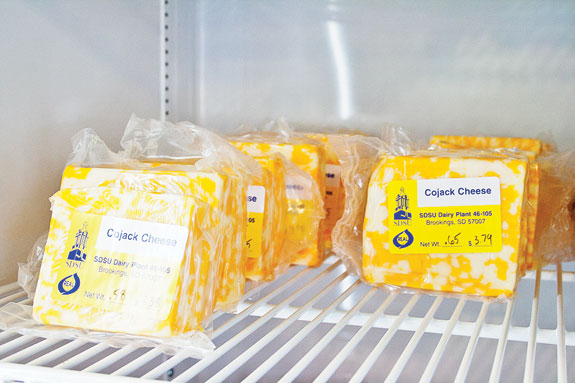
Cheese and fluid milk are processed once a week. However, ice cream requires a two-day process. One day is spent mixing and pasteurizing the ice cream mixes. The ice cream is then frozen on the following day.
“The milk truck will come right from the farm and drop the milk off here, where it will then go into two 6,000-gallon storage silos and then through a separator,” Anderson says. “The fluid milk, cheese and ice cream mix will eventually go through a pasteurizer, which is rated at 7,500 pounds per hour.”
The type of dairy product being produced on a given day will determine the equipment in the plant that will be used.
A raw cream tank, a pasteurized milk tank, a blender and a reconstitution tank are only some of the equipment pieces.
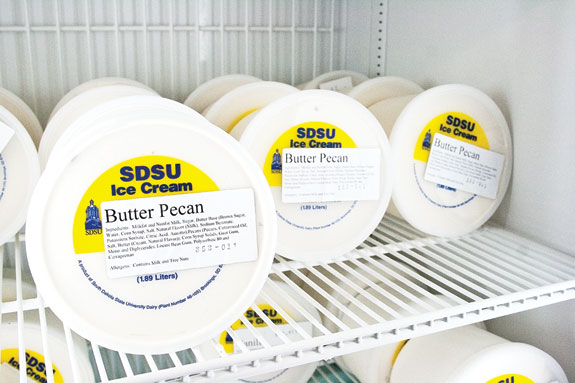
The reconstitution tank is used for chocolate milk mix or ice cream mix. When cheese is being processed, a 2,500-pound horizontal cheese vat and a 1,000-pound double O cheese vat are used in the process.
Developing tomorrow’s managers
However, the new plant offers more than just dairy products; it also provides learning opportunities for students.
Through the dairy plant, students have opportunities to learn and be trained in a state-of-the-art facility. Students that work at the plant are exposed to hands-on work in this type of setting.
Anderson says he had 16 students working at the plant this past spring, but the number varies from semester to semester. For the upcoming fall semester, he expects to have between 15 and 20 student workers.
“We schedule students around their class schedules because classes come first,” Anderson says. “We’ll have some students that will want to put in five hours a week and then other students that want 20 to 30 hours a week.”
The students’ responsibilities in the plant encompass working in all areas of the facility. Anderson says the students start the equipment in the morning and are in charge of processing the product as well as shutting down equipment and cleaning up at the end of the day.
“One of my main jobs is to make sure the students are getting the best education in the plant that we can provide them,” he says. “We want the students to be as involved with the process as they possibly can.”
He explains that upgrading from the previous facility to a new, fully automated facility will make a big difference in the training of students. “The old facility was really outdated where everything was operated manually,” he says.
Now, the entire facility is fully automated and operated from touch screens located throughout the plant.
The touch screens allow workers to see if the equipment is running correctly and also control any valve, pump or piece of equipment.
“That was probably one of the biggest learning curves for our students when they left here and went out into the industry,” Anderson says. “It was kind of a culture shock for them to see how everything was fully automated and run off of computers.”
Anderson adds that becoming trained with automated systems is making SDSU students more valuable to the industry upon graduation.
“Having the same technology that is out in the industry is really going to shorten the learning curve of our students,” he says.
The dairy plant also opens its doors to undergraduate and graduate students looking to conduct research on dairy products.
“We had several students in the past who have had an interest in undergraduate research projects or helping out our graduate students on their graduate research projects,” Anderson says.
Recently, a May SDSU graduate developed a new ice cream flavor as an undergraduate research project.
“She came up with a flavor idea and the ingredients, and then mixed up several different batches and dosages of those ingredients to get to her final product,” he says.
Anderson explains that while it is a challenge at the plant, he also enjoys teaching new students and students with no experience in the dairy industry the ropes of working in a dairy processing plant.
He explains that a favorite part of his job is working with students and being a mentor to them.
“I’ve been in this position for a year-and-a-half now,” he says. “I really look forward to just seeing the students develop into our future plant managers and supervisors.”
Supporting the industry
In addition to offering educational and training opportunities to students, the dairy plant supports the dairy industry in other ways.
During the holiday season, the dairy plant works with the university’s dairy club in providing the cheese for the club’s holiday cheese box fundraiser.
Additionally, Anderson explains that the dairy plant and the equipment within the facility are available for the industry to use.
Industry-related personnel are able to use the facilities and equipment to conduct research to help develop new dairy products, create new processes or run product trials on smaller scale.
“Now that we have this up-to-date, modern facility, we also have to continue to work to make sure this little plant keeps up with the upgrades and the technology of the rest of the industry,” Anderson says.
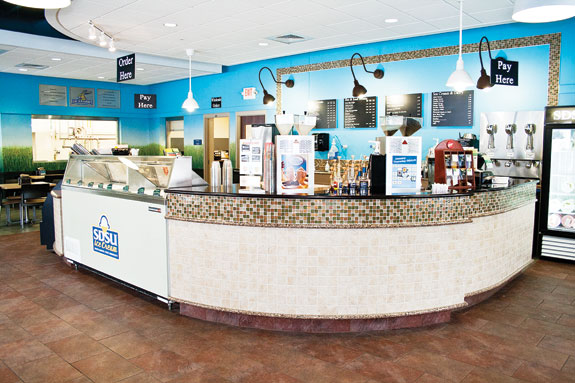
Growing along with the industry is only one focus for the new plant. Anderson hopes the facility will serve as a representative of SDSU’s dairy science program, ultimately helping with recruitment and increasing program enrollment numbers.
“With the new facility, we’ll be able to push out more of our SDSU dairy products,” Anderson says. “We also hope the SDSU ice cream label becomes more and more popular.”
Tourists and ice cream enthusiasts and can get a taste of SDSU’s dairy products at the Dairy Sales Bar, which is connected to the dairy plant on campus.
The bar has a viewing area set up for visitors to see a glimpse of the process of how the ice cream they are enjoying is made. PD
Click here for more information about SDSU’s Davis Dairy Plant.
PHOTOS
TOP RIGHT: SDSU’s Davis Dairy Plant
TOP MIDDLE RIGHT: SDSU’s Davis Dairy Plant Manager Jake Anderson explains the plant’s state-of-the-art features including a fully automated system allowing employees to operate equipment via touchscreens located throughout the plant.
MIDDLE RIGHT: Fluid milk, ice cream and cheese are the three main dairy products produced at the dairy plant.
BOTTOM MIDDLE RIGHT: Ice cream enthusiasts can get a taste of SDSU’s ice cream on campus at the Dairy Sales Bar.
BOTTOM RIGHT: Dairy Sales Bar. Photos by Dario Martinez .

Dario Martinez
Editor
Progressive Dairyman magazine
